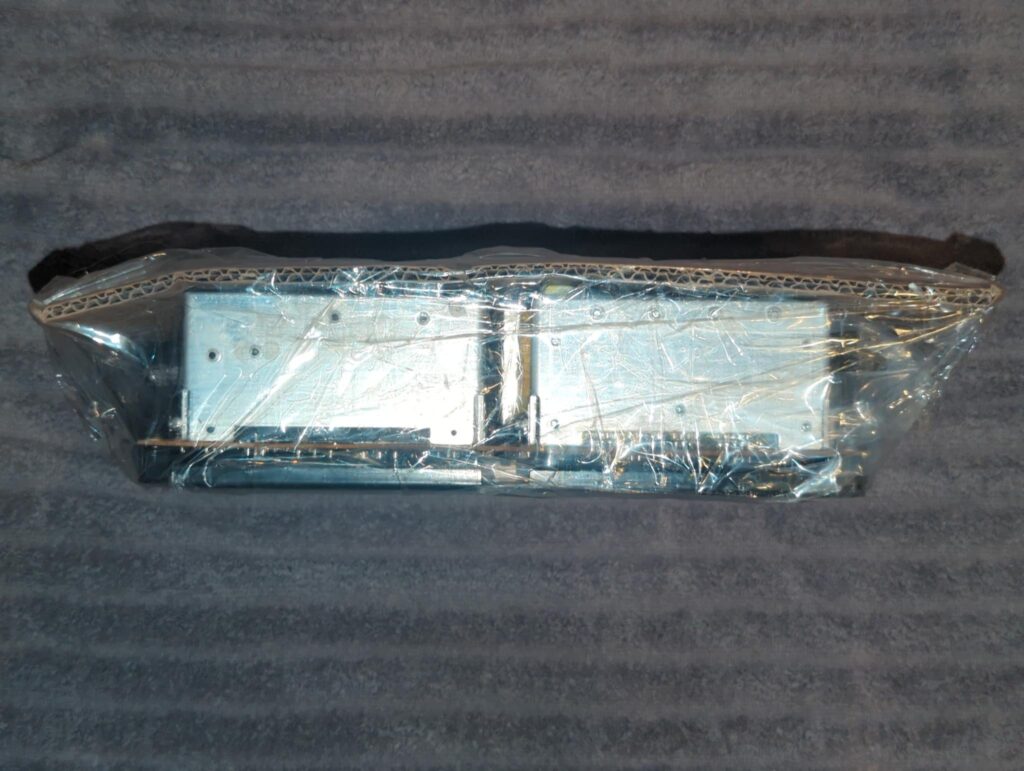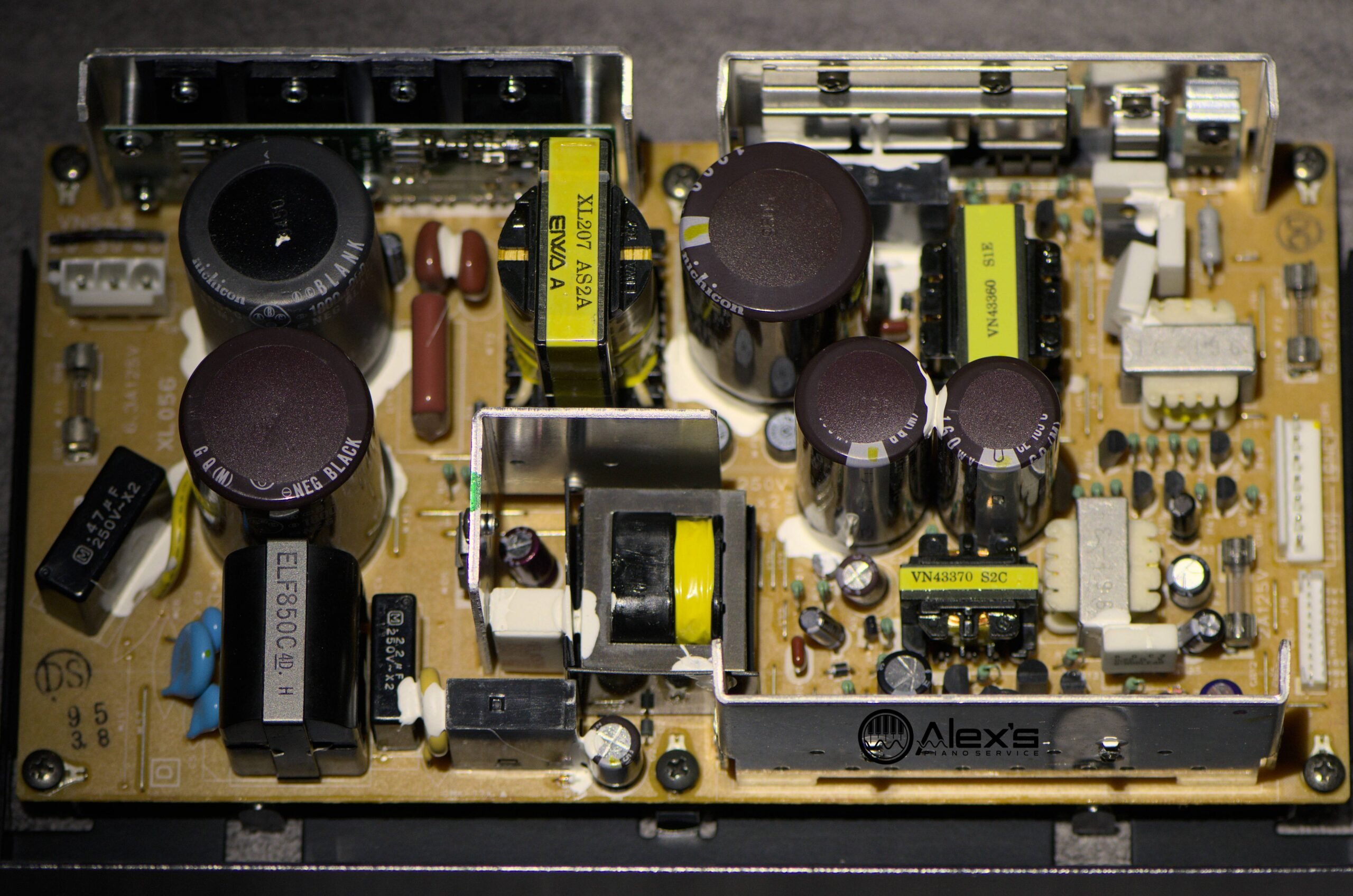Over the years, I’ve replaced the power supplies on most of the Mark II generation Disklaviers I’ve worked on. These second-generation Disklaviers are terrific instruments—until the original power supply quits. When it does, the piano either won’t turn on, whines loudly, or randomly shuts off after running for a short period of time. This also applies to Mark II XG and Mark III systems, such as the DKC-500RXG and DKC-55R.
Power supply failure can occur on other generations of Disklavier, but it’s rarer. And no matter the generation, once the power supply is rebuilt, protect your Disklavier with an adequate surge protector.
What are the symptoms?
The Disklavier won’t turn on at all
Pushing the power button causes a faint clicking sound, and nothing further happens. Sometimes the screen briefly flashes. This is the classic symptom of power supply failure, and it often happens when the piano is power cycled repeatedly.
It spontaneously shuts down after a short time
The piano runs for a few seconds, or perhaps even minutes, before powering off spontaneously. There will be no shutdown message displayed on the screen—power simply cuts out.
There are loud whining or hissing noises
The piano may run, but there’s a clear, loud whining sound coming from the bottom of the instrument. I first encountered this with an HQ100 (the Japanese version of the MX100II).
Consider These Possibilities before Replacement
A worn or unreliable power switch
Sometimes a worn power switch mimics a dying supply. While the piano is on, gently wiggle the button. If the system shuts down, replace the switch (a cheap part) before shipping the supply.
The Yamaha part number for the switch is VN388300 (discontinued). The switch itself is an ALPS SPPH23. Recently, a reader reached out to inform me that the ALPS SPPH230100 is now available on eBay! You can find this switch on eBay here. A visitor recently donated me a large supply of them, so if you contact me directly, I can send you one for the cost of postage.
An overheating 100 V Japanese power supply
Make sure your Disklavier isn’t a “gray market” Japanese model that expects 100 V. Here in North America, our outlets supply 120 V. Running one of these pianos at full U.S. voltage can cause overheating that mimics a failing power supply. Look for Japanese text on the control unit, or for markings indicating “100 V” around the power cord. A Nissyo step-down transformer can be installed on the back of the piano to supply a steady 100 V.
Who can fix it?
The majority of technicians, including Disklavier technicians, do not fix the power supplies themselves. There are two rebuilders I personally would recommend:
TAP Electronics
I’ve used TAP Electronics for years, and they were initially recommended to me by Yamaha. You should specify that you also want the capacitors replaced. Old electrolytic capacitors can become unreliable and cause further damage, so if you’re rebuilding the power supply anyway, do this as well.
Pricing: $850 including return shipping (as of July 2025)
Website: https://www.tapelectronics.com/
Ground Grown Circuits (Noah Jolly)
If you’ve had much correspondence with Yamaha, you might have already encountered Noah. He’s a multi-talented individual and refurbishes these power supplies fully. His price includes replacing the original unreliable components, all electrolytic capacitors, and any other failed parts he finds. It also includes repairing traces damaged by leaking electrolytic fluid. He includes return shipping via UPS Ground.
Pricing: $999 including return shipping (as of July 2025)
Website: https://www.groundgrowncircuits.com
Can I remove it myself?
If you have an upright Disklavier and are comfortable with DIY repair work, you might choose to remove the power supply yourself. Be mindful that the capacitors are large, and that there’s voltage even when unplugged. Do not attempt this if you’re at all uncomfortable: A technician can remove it quickly without meaningful risk to themselves or the instrument.
- Unplug the piano and press the power button. Then wait ten minutes. Pressing the power button helps to discharge power stored in the unplugged piano.
- Remove the kick panel above the pedals. This is held in place with a leaf spring (or two) at the top of the panel.
- Locate the power supply. It’s the metal box at lower right. It mounts directly to the bottom of the piano, and you’ll see several large capacitors.
- Photograph cable positions. The cables are all unique, so it is intuitive to reconnect properly. But if you’re unfamiliar, it’s a good idea to keep a record just to be safe!
- Loosen the mounting screws. There are screws holding the power supply to the bottom board. Loosen them and slide the power supply sideways to release it.
- Pack the power supply.
Own a grand Disklavier? Call a technician. In order to remove the power supply, you’ll have to either remove the piano’s action, or do some more complicated surgery.
How do I ship a power supply?
Pack it securely! Use a double-wall box, 2–3″ padding on every side. Bubble-wrap the unit; no loose screws or cords in the box. Include a letter with your contact information, piano model and symptoms, and—for TAP—“Please rebuild and replace all electrolytic capacitors.” And insure for at least the rebuild cost.
I use Pirate Ship for mailing my packages. The service itself is free, and you can end up paying a quarter the price you would if you shipped from your local post office or UPS location.

